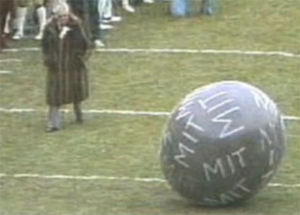Hack Secret Revealed in 2.007 Contest
-
-
slice.mit.edu
Filed Under
Recommended

White lipstick? That’s a secret ingredient used in the famed 1982 hack that left fans of the Harvard-Yale football game gaping when a weather balloon emerged from the field and inflated to display large MIT inscriptions.
The secret was revealed by John West ’78, SM ’80, president and CEO of ViaCyte, in early May. West shared the insider knowledge as part of the run up to the legendary 2.007 robot competition, which this year focused on robots that could reenact major campus hacks. Although he didn’t say how he came by this knowledge, he seemed intimate with the design details including how many years in advance the inflating device was made and where it was tested. And the white lipstick? That’s what the student designers used to draw “MIT” on the balloon because of lipstick's flexibility.

Models of MIT’s Great Dome, Killian Court, and the Harvard football field were constructed for the 2011 competition by 2.007 teaching assistants Amelia Servi ’09 and Greg Tao ’10. Students hit the fields with either a multi-functioning robot or several robots each devoted to one task. Competitors, who earned points for every hack accomplished, used video-game controllers, iPads, and laptops to control their 'bots. You can see short videos of 47 student competitors describing their devices.
And the winner? Sophomore Wyatt Ubellacker took first prize for his formidable team of three robots: a simple coffee-cup-carrying ball dropper, a robo-reeler built to manipulate the Caltech cannon, and a robotic arm that inflated the MIT balloon over the Harvard football field.
Check out Hack History, a student website, for updates including the arrival of the TARDIS at MIT last fall and its mysterious appearance at Caltech, UCBerkeley, and Stanford this year.







